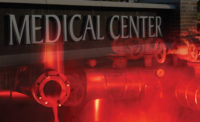The production of thermal power is critically important in carrying out the mission of health care facilities where it is used for space heating, humidification, domestic water heating, and for processes in dietary, laundry, and sterilization departments. The age of the hospital, the programs offered, and the regional climate will all affect the demand for thermal power.
The Commercial Building Energy Consumption Survey (CBECS) data showed that large hospitals accounted for 2% of all commercial floor space, but consumed 4.3% of total commercial sector energy use in 2003. By 2007, CBECS data indicated that this share had increased to 5.5% of commercial building sector energy use.1
Benchmarking has become a popular tool for comparing energy use to similar facilities with the goal of managing and conserving its use. However, much of the available data is at the whole-building level and not the system level. Research by the University of Washington’s Integrated Design Lab (IDL) worked to shed some light on system level energy use where they took utility data from a hospital in Vancouver, WA, and adjusted it using electrical monitoring and calibrated energy models to come up with the component breakdown for energy use in the hospital shown in Figure 1.
It should be noted that this hospital performs better than most in the U.S. and was opened in two phases in 2005 and 2009. Even though it is located in a mild climate, thermal power from fossil fuels totals nearly 55% of the total energy consumed with the largest percentage attributed to reheat at 42%.
Thermal Power Production and Distribution
Thermal power can be produced in a number of ways including the direct combustion of fuels, the conversion of electric power to heat, and through chemical reaction. Combustion can use fossil fuels such as coal, natural gas, oil and propane, or renewable biofuels from animal or plant derived material. Electric power can come from the combustion of fossil fuels and biofuels, as well as from nuclear, hydro, wind, and photovoltaic sources. Hydrogen ions reacting with oxygen in a fuel cell will simultaneously create electric and thermal power.
In the U.S., both thermal and electric power is generated primarily by the combustion of fossil fuels. The use of cogeneration is a way to simultaneously produce electric power and use the waste heat from the process for domestic water heating and the reheat needs of a hospital. This can save a significant amount of source energy and is beneficial to the environment and may be economically beneficial to the enduser in some regions of the country either due to differences in gas and electric cost or the remoteness and unavailability of electricity. Although the study of source energy is an interesting topic, this article will focus on site energy reduction.
Thermal power generation starts at the central boiler plant, which should have redundant capacity and backup fuel to ensure that no significant interruptions occur to the functions of the health care facility that would affect patient outcomes. In the U.S., natural gas is the predominant primary fuel, with No. 2 oil as a backup. A typical configuration would have three equally sized boilers where only two would be required to meet peak power needs during the coldest months of the year. At these times, there would be two boilers operating with the third boiler in “hot standby” in case it is needed due to a primary boiler failure. So in effect, there are three large pieces of equipment radiating energy 24/7.
In the summer this plant would have one boiler operating, one in hot standby, and the third in “layup.” Some facilities may require the operation of two boilers even during the summer months to accommodate domestic hot water loads, process loads, and to just keep the extensive piping network hot. Ask a boiler operator how much instantaneous steam production is required at midnight in August, and you might be amazed at the amount of energy required to offset heat loss from the distribution piping as well as from boiler radiation and blowdown.
The production and distribution of steam on a large scale is common especially in northern climates as it is very useful and versatile in operating a hospital. However, the production of lower temperature hot water in a condensing boiler is thermodynamically more efficient. The energy released through combustion in a boiler is absorbed through radiation, convection, and conduction.
A typical steam boiler will operate at a pressure of 120 psig, at saturated conditions where the steam product is at a temperature of roughly 350°F. By contrast, a condensing hot water boiler may be delivering 130°F water and returning 100°F water, which allows it to extract energy more effectively from the flue gases as there is a larger temperature difference between the products of combustion and the thermal fluid. Condensing boilers are typically smaller than steam boilers and don’t need to be kept in hot standby, which results in less radiation and convective losses.
The piping distribution losses from steam systems are greater due to the higher temperatures involved. This effect is amplified by many components such as large valve bonnets and traps associated with these systems being difficult to insulate and consequently often going without. Lastly, steam systems are subject to losses from boiler blowdown and from faulty traps.
Older steam plants often have equipment such as feed water pumps, forced draft fans, and induced draft fans that are driven by steam turbines. Whenever steam driven equipment is encountered, it should be on the list to be analyzed for replacement with electric motors since turbines are extremely inefficient, consuming large amounts of thermal power. Steam plants can also be home to many misguided improvements made over the years, such the installation of absorption and steam turbine-driven chillers. These “improvements” usually have the justification of getting oversized steam boilers operating at their “sweet spot” during the summer months. It is usually better to investigate the installation of a smaller “summer boiler” instead of wasting steam on inefficient processes in the name of energy efficiency.
Target: the major thermal consumers
Minimizing steam production is one of the keys to reducing thermal power in the health care environment, and the key to that is to obviously minimize its consumption. One place to look in both existing and planned future facilities is humidification.
Many hospitals were designed and built in an era when practically the entire facility required humidification to meet standards and guidelines. In fact, less than 10 years ago, ASHRAE recommended humidifying many more spaces than it does today. Around that time, the organization spearheaded an effort to unify healthcare ventilation and humidification guidance through ASHRAE Standard 170, Ventilation of Health Care Facilities, to represent current thinking. The most recent version (2013) has minimum humidification requirements in select areas such as operating rooms, endoscopy, burn units, nursery, delivery rooms, and critical and intensive care. Most of these areas have also had the minimum relative humidity level decreased from 30% down to 20%, whereas many other areas no longer have minimum humidity requirements.
It should be noted that state health departments may have standards that do not align with ASHRAE Standard 170, but it is worth checking in with them as they may allow designing to the current standard. Our firm met with a health department in the Midwest recently to discuss the design of a replacement hospital where we were able to reduce the floor space needing humidification by nearly 90%. Not only was first cost saved, but operating cost as well. In existing hospitals, there is the possibility that much of the steam piping network could be removed or disconnected thereby reducing plant load requirements and saving thermal power. Although alternative humidification methods can minimize steam consumption, the use of evaporative media or atomized water should not be used in a health care setting since these technologies have been associated with biological growth.
Sterilization, laundry, and dietary functions require equipment such as autoclaves, sterilizers, cart washers, steam kettles, dishwasher heat exchangers, dryers, and ironers. Although they may represent a small fraction of the overall thermal energy consumption of a health care facility, they are nonetheless critically important to fulfilling its mission. Since steam has historically been present at hospitals, it is no wonder that the dietary, sterilization, and laundry equipment has been designed around having access to this remarkable heating medium.
In hot humid climates, the need for steam to humidify and heat ventilation air is virtually non-existent, so the development and use of equipment that generates steam locally has taken hold. It is possible to build a “steamless laundry” with the use of natural gas-fired equipment. Many sterilizers and autoclaves can be selected with integral electric steam generators. The use of this type of equipment can go a long way to liberate the health care facility from the need to generate and distribute steam from a central plant.
Domestic water heating can have a significant impact on the sizing of the central heating plant due to large calculated peak loads, even when using the modified Hunter’s Curve. ASHRAE has sponsored research that will hopefully reconcile the disparity between theoretical and actual domestic hot water demand. Due to concerns over Legionella control and the introduction of ASHRAE Standard 188, Legionellosis: Risk Management for Building Water Systems, generating hot water with little or no storage volume seems prudent. The easiest way to do this is with instantaneous or semi-instantaneous steam-to-water heat exchangers. This approach also solves the issue of having a backup fuel source, as the central steam plant in the U.S. will invariably be fired on natural gas with No. 2 fuel oil in case of interruption or curtailment.
The intermittent nature of domestic hot water use and the desire to reduce or eliminate storage volume creates a scenario where the central steam plant capacity requirements are driven higher to accommodate these peak loads. Ideally, it would be beneficial to have independent domestic water heaters that can fire on two fuels and that have small storage volumes, thereby avoiding the need to generate steam in a central plant. In addition, these domestic water heaters would be the condensing type to maximize energy efficiency. Currently, this product does not exist and presents an opportunity for equipment manufacturers to fill a need in the health care marketplace.
Another option is to have a combination plant that uses gas-fired, condensing water heaters as the primary source of potable water heating and then have partial steam backup in case there is an interruption of natural gas service. This approach requires having a storage volume, but if kept at high enough temperature, Legionella growth would be of minimal concern.
Preheating, reheating, space heating, and thermal mixing are the big thermal power users in hospitals. Large amounts of fresh air are required to accommodate the various health care functions of a hospital. Although there is debate on this subject, fresh air is associated with a healthy environment; for instance, patient rooms require a minimum of two ACH of fresh air while operating rooms require four ACH.
Many ventilation systems in northern climates have a mixed air temperature that is below the desired system supply air temperature, and therefore, heat must be added to the airstream. This is often accomplished with a pre-heat coil that is situated just downstream of the pre-filter section. The use of enthalpy wheels or other methods of heat recovery can be used to minimize or eliminate the amount of pre-heating required. Heat recovery may be a code requirement depending on the climate and the energy code that is in effect for the particular jurisdiction.
Ventilation from a central AHU is typically distributed at 55°F except for special areas such as surgery where the need for colder space temperatures require lower discharge air temperatures. The energy required to elevate the temperature of this air to the room setpoint temperature would be considered reheating, whereas raising it above the set point would be considered space heating. Figure 1 indicates 42% of that hospital’s energy use is consumed by reheating air, which is a large and somewhat wasteful energy expenditure that can be avoided in some instances. The author’s interpretation is that this 42% figure includes both reheating and space heating.
New construction or major renovation projects of patient towers could benefit from exploring the use of fan coil units or chilled beams to eliminate reheat. Zoning of air handlers for interior and exterior zones can help to significantly reduce the amount of reheating required as the discharge air temperatures can be reset more effectively. Dual-duct and multi-zone ventilation systems are examples of thermal mixing. These outdated and thermally inefficient systems should be replaced when major capital improvements are undertaken.
CONCLUSIONS
Thermal power is a significant component of health care facility energy use and can be reduced in a number of ways that start at the boiler plant. Minimizing steam production and replacing it with hot water generation where possible is a great first step.
Other steps include the use of a heat recovery chiller to move heat from areas like data centers to hot water production; replace steam-driven turbines with electric motors; humidify to current standards; select sterilizers and autoclaves with local steam generators; choose steamless laundry equipment; use air-side heat recovery equipment for ventilation; consider use of fan coils or chilled beams for patient rooms to avoid reheat; replace antiquated dual duct and multi-zone ventilation systems. Finally, the manufacturers of boilers and domestic water heating equipment need to develop a high-efficiency, dual-fuel product offering. ES
Schultz leads AECOM’s National Healthcare MEP Practice. He is a corresponding member of ASHRAE’s Healthcare Technical Committee and is an Associate Member of ASHE. He can be reached at carl.schultz@aecom.com.
References
1.
CBECS 2007 — Release date: August 17, 2012. Retrieved from https://www.eia.gov/consumption/commercial/reports/2007/large-hospital.cfm
2.
Targeting 100! Energy Use and Model Calibration Study: Legacy Salmon Creek Medical Center Vancouver, Washington. University of Washington (IDL 2011).





